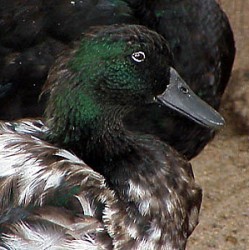|
Project Quack
|
|
Cayuga |
| |
| Cayuga ducks are one of the few
domestic duck breeds that originated in the U.S. The Cayuga breed is thought to
have been developed from a pair of wild black ducks a miller caught on his pond
near Lake Cayuga in New York in 1809. The miller removed a joint in their wings
to prevent the ducks from flying away, and the two ducks began to settle on the
edge of his pond and began mating and multiplying. Breeders introduced these
ducks to the Finger Lakes region of New York in 1840. By 1863, these black
ducks bore the name of the lake in northern New York named after the native
Cayuga people. |
 |
| Cayuga ducks are
considered a medium-sized breed that grows to be between 7 and 8 pounds. Their
bodies are long and wide with a deep chest and abdomen. They have oval heads,
long bills that are slightly concave along the top, and necks that are slightly
arched forward. Cayuga plumage is uniformly black-green and sometimes will
become speckled with white feathers as the bird grows older. Their bills are a
dark bluish gray, and their feet are dark gray to black. |
|
|
|
|
|
| The Cayuga has long been recognized as
one of the hardiest of domestic ducks. They are active foragers if allowed to
run in areas containing natural foods. This bird averages 100-150 eggs per
year; the shells of these eggs are black early in the season and they progress
to light gray, blue, green, or white as time passes. The temperament of this
breed is quiet and calm, and generally Cayugas can be easily tamed if
hand-raised. |
|
| |
|
| |
|
|
|
|
| |
 Webspinner Table of Contents Webspinner Table of Contents |
|